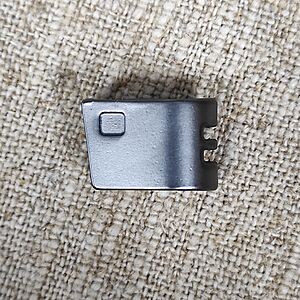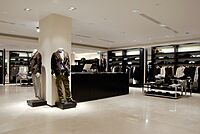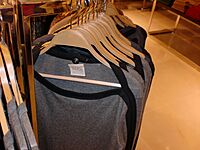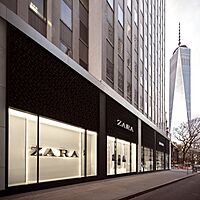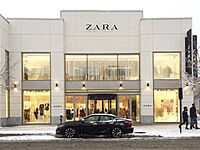Zara (retailer) facts for kids
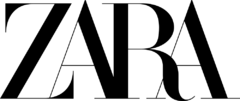 |
|
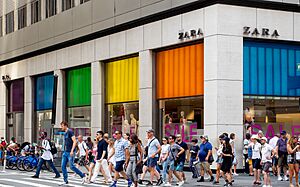
A Zara store in Midtown Manhattan, New York City
|
|
| Industry | Retail |
|---|---|
| Founded | 1975 (as Zorba) in Spain |
| Founders | Amancio Ortega Rosalía Mera |
| Headquarters |
Arteixo, Spain
|
|
Number of locations
|
2,007 stores |
|
Area served
|
Worldwide |
| Products | Clothing |
| Revenue | €19.586 billion (2021) |
| Parent | Inditex |
Zara is a popular clothing store from Spain that is known for fast fashion. This means it makes new styles of clothes very quickly. Zara is a part of a larger company called Inditex.
Besides clothes, Zara also sells accessories, beauty products, and perfumes. The main office is in the city of Arteixo in Spain. The brand is always creating new things, and in 2020 alone, it released more than twenty new product lines.
Contents
History of Zara
How Zara Started
Zara was started by Amancio Ortega and Rosalía Mera in 1975. Their first shop was in the city of A Coruña, Spain. At first, they named the store 'Zorba' after a famous movie. But, there was already a bar with the same name nearby. So, they rearranged the letters they had to make the name 'Zara'.
The first store sold less expensive copies of popular, high-end clothes. Soon, Ortega opened more shops across Spain. In the 1980s, he changed how the company designed, made, and sold clothes. He used computers and teams of designers to create "instant fashions." This allowed Zara to react to new trends much faster than other companies.
Growing Around the World
In 1985, Zara opened its first store outside of Spain in Porto, Portugal. The company then expanded to the United States in 1989 and France in 1990. During the 1990s, Zara opened stores in many more countries, including Mexico, Greece, and Sweden.
From 2000 onwards, Zara continued to grow. It opened stores in countries like Japan, Russia, China, and South Korea. In the 2010s, it reached India, Australia, and South Africa.
In September 2010, Zara started selling its products online. The online store first launched in Jordan and then expanded to other countries. Now, people can shop at Zara online in many places, including the United States, Canada, and Mexico.
In 2019, Zara changed its logo to the one it uses today. By 2023, Zara had nearly 3,000 stores in 96 countries. That same year, Zara sold its business in Russia, and the stores were renamed Maag.
What Zara Sells
Zara stores sell clothes for men, women, and children (Zara Kids). Some stores in Europe also have a Zara Home section with items for the house. Most of Zara's customers are between 18 and 35 years old.
The company is famous for how quickly it gets new designs into stores. After a new clothing item is designed, it only takes about 10 to 15 days for it to be ready to sell. All clothes go through a main distribution centre in Spain. There, they are checked, sorted, and tagged before being sent to stores all over the world. Most items arrive at the stores within 48 hours.
In May 2021, Zara launched its first-ever makeup line, called ZARA Beauty.
How Zara Makes Its Clothes
Zara can create a new product and have it in stores in just one week. This is much faster than the average of six months for other clothing companies. Each year, Zara makes about 40,000 designs, and around 12,000 of these new designs are produced and sold.
Fast and Local Production
Instead of spending money on advertising, Zara uses its money to open new stores. The company has its own factories in Spain, Portugal, and Turkey. This is where it makes its most fashionable items. This allows Zara to make clothes quickly and respond to what customers want.
Clothes that have a longer shelf life, like basic T-shirts, are made by suppliers in other countries, mostly in Asia.
Responding to Customers
Because Zara can make clothes so quickly, it can keep up with the latest fashion trends. If a new design doesn't sell well in its first week, it is removed from the stores. The company then stops making that item and starts working on a new design.
This strategy encourages shoppers to visit the stores often to see what's new. A typical clothing store might see a customer three times a year, but for Zara, it's about 17 times a year.
Online Shopping and Second-Hand Clothes
With more people shopping online, Zara has started to focus more on its website. It now opens fewer, but larger, physical stores. In 2022, the company also launched a platform in the UK for people to sell their used Zara clothes. This service allows shoppers to sell, repair, or donate their old items. This platform was later expanded to the U.S. in 2024.
Protecting the Environment
In 2011, the environmental group Greenpeace reported that some clothing companies were using harmful chemicals. Greenpeace asked Zara to stop using these substances in its production process.
Nine days later, Zara agreed. The company promised to remove all hazardous chemicals from its products and supply chain by 2020. Zara became the largest retailer in the world to support the Greenpeace "Detox Campaign."
Zara also created a special laundry detergent with its Zara Home line. This detergent helps reduce the number of tiny plastic fibres (microfibres) that wash off clothes and pollute the water.
Zara's Logos Through the Years
Images for kids
-
The men's department of a Zara store in Almere, Netherlands.
-
A Zara clothing tag showing it was made in Portugal.
-
A Zara store in Columbus, Ohio.
See also
 In Spanish: Zara para niños
In Spanish: Zara para niños
- Bershka
- H&M
- Shein


